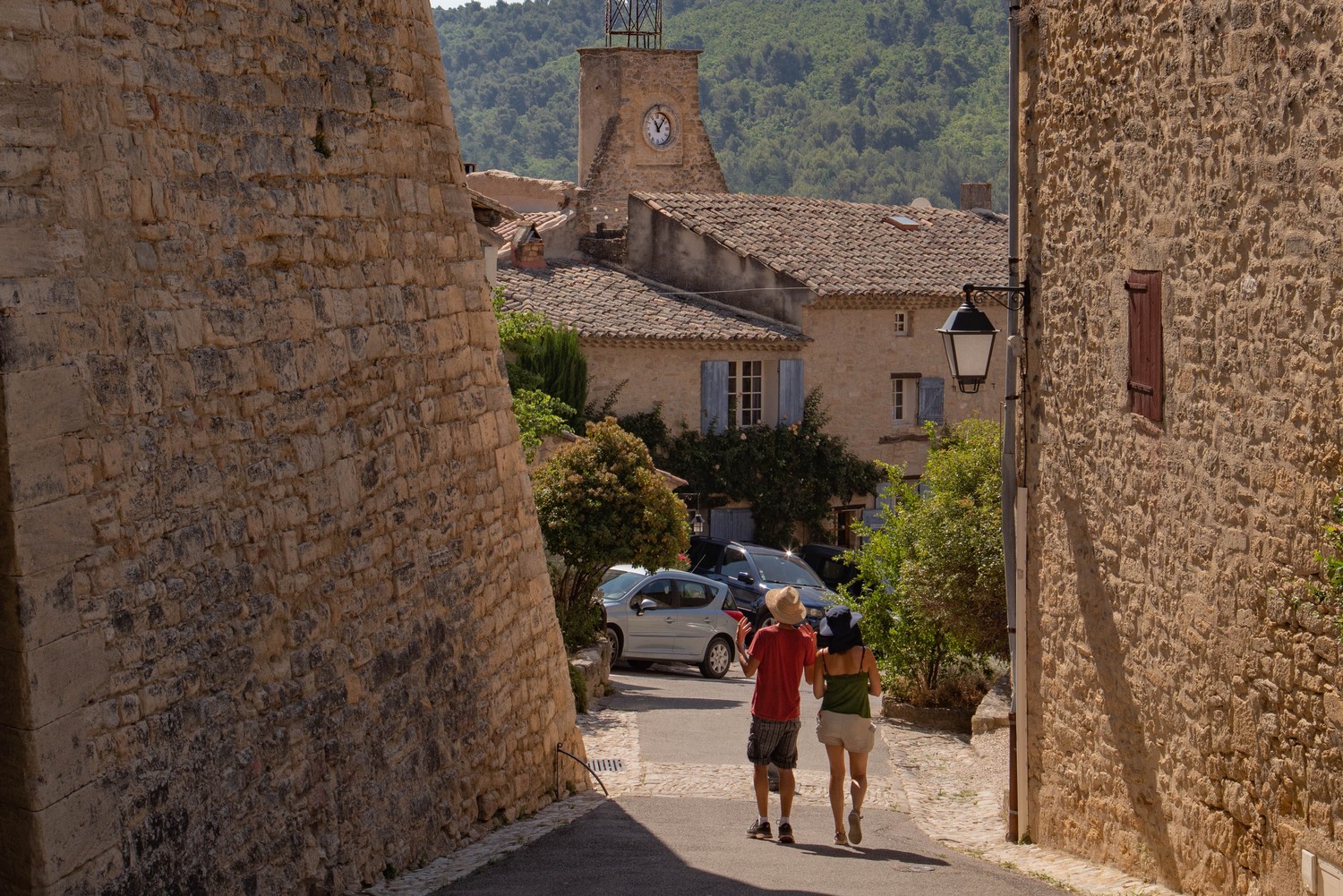
Ansouis, between alleys and cobblestone streets
"I love this hilltop village! Ansouis offers a true Provençal setting. Open your eyes and wander its streets to discover its heritage revealing imprints of the past. Visit the craftsmen: Art jewelry, santon-makers, ceramicists and painters. But do not forget to have coffee in the shade of plane trees in the Place des Hôtes, a typical small village square! " says Séverine Besson, Task Officer for the Valuation of assets at the south side Luberon Tourist Office.
13 points of interest
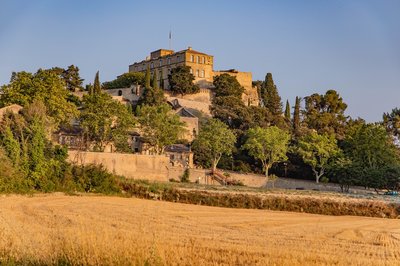
Château et village d'Ansouis - ©Alain Hocquel - VPA  Patrimony and history
Patrimony and historyAnsouis, a hilltop village
The village developed from the 10th century around the castle and the church (11th century) located at the top of a hillock. Positioned at a strategic intersection of old roads, Ansouis was the administrative and trading centre of a barony consisting of Cucuron, Sannes and Motte d'Aigues. Less influential (crisis of the 18th century), less populated (rural exodus of the19th century), the village has kept its dense urban form of the 16th century making it its charm and a rare and precious proof.
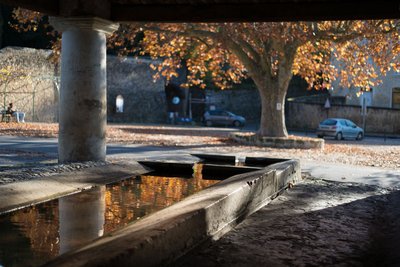
Lavoir d'Ansouis - ©Commune d'Ansouis  Patrimony and history
Patrimony and historyThe washhouse of Ansouis
Typical with two basins - one for washing and a second one for rinsing with the arrival of water, that had to be very clean. The clothes were soaked in the water by the women, then scrubbed with "soap of Marseille" known to be one of the best detergents, then it was roughly struck several times to the “battoir” to evacuate the dirt and the soap. Rinsing required twisting and bending the laundry before draining. Some women made it their profession: The washerwomen.
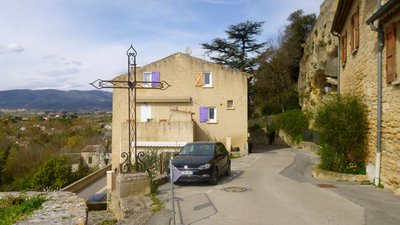
Emplacement du Grand portail - ©Séverine Besson - OT Luberon Côté Sud  Patrimony and history
Patrimony and historyOld entries
There remains only the location of the Grand Portal on the current road. The forged iron cross reinstalled by the parish in 1951 symbolizes this ancient village entrance. The spiral ramp, used today, is modern. Presumably built west of the old, it rests on the north side of the tower. Little Portal, in the street of the same name, is the only door still nowadays state.
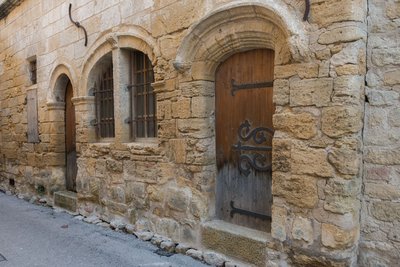
Maison des Consuls d'Ansouis - ©Commune d'Ansouis  Patrimony and history
Patrimony and historyMaison des Consuls
This house was the seat of the City Council in the fifteenth century. and sixteenth century. The lower part has openings hanger topped with moldings which one can think of a window of shop. Indeed, the ground floor housed the grain silos, oven, stalls with meat and fish that were intended, if the village office, to supply the inhabitants who sought refuge in the castle .

Le château d'Ansouis - ©Séverine Besson - OT Luberon Sud Tourisme  Patrimony and history
Patrimony and historyCastle Ansouis
The castle, built in the Middle Ages on top of a rocky outcrop, was a vantage point. Four towers and a central tower, it has a strong fortification system. In the seventeenth century., Peace reigning again in Provence, the castle is transformed into pleasure residence. Occupied for nearly 1000 years by the Sabran family, the new owners since 2008 continues the restoration and the castle open to visitors.

Entrée de l'église Saint-Martin - ©Séverine Besson - OT Luberon Sud Tourisme  Patrimony and history
Patrimony and historyThe Church of St. Martin
Difficult to date this building, it's probably not earlier than the end of the twelfth century. It consists of a three-row nave and an arched transverse vessel broken barrel. various sculptural elements One notices. This church, probably built in the days when the village knew its maximum population, was not enlarged thereafter and suffered only a few minor alterations.
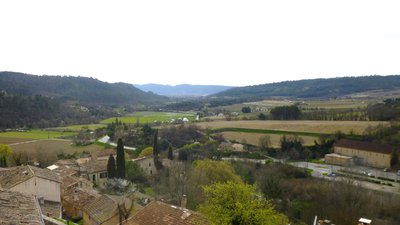
Percée vers la Durance - ©Séverine Besson - OT Luberon Côté Sud  Panorama
PanoramaThe vines, the valley and the Durance
At the level of the terrace in front of the church and the castle, from the "barri" (rampart wall), is a privileged panorama on the Luberon. Beyond the vines, on the right, the view extends from Lourmarin and its valley separating the Petit Luberon from the Grand Luberon (west), as far as Cucuron (east). To the left, in the direction of Villelaure, there is also a breakthrough towards the Durance.
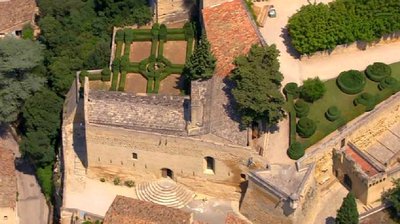
Jardins suspendus - ©DR  Patrimony and history
Patrimony and historyA castle, but also ...
The present building, erected mainly between the 13th and 15th centuries, was built on a base of the 10th century. ; The rectangular main building dates from the 17th century. The old vaulted kitchen contains a set of 18th century Provencal furniture, a Renaissance fireplace and a "potager" (old stone warming oven). Around, terrace-gardens have been developed in a French style, dominating the village. The castle, its park, the ramparts and the square tower are classified Historic Monuments.

Beffroi d'Ansouis - ©OT Luberon Sud Tourisme  Patrimony and history
Patrimony and historyThe belfry of Ansouis
The council of the community of Ansouis held its sittings in the house of the brotherhood of the Holy Spirit from 1540. After the dissolution of the Brotherhood, the house became communal property and turned into City Hall and oven. above the belfry were built, crowned with a forged iron bell tower, which houses the clock and was probably built between the late sixteenth century. and early seventeenth century. This town hall was replaced by the former town hall on an unknown date between 1793 and 1836.

Le Petit portail (extérieur) - ©Séverine Besson - OT Luberon Côté Sud  Patrimony and history
Patrimony and historyThe Little Portal
Only one door out of three is still in state. It pierces the second enclosure and opens in the center of the southern curtain. Highly redesigned, it has a modified segment arch and three raised brackets (superimposed "S" shapes used as a support). They could be old machicolations, whose perforated floor made it possible to launch projectiles to protect this vulnerable zone. The importance of this entry gave the name to the street below.

Le meunier, par Daniel Galli - ©DR  Savoir-faire
Savoir-faireThe santon maker of Ansouis
Over the centuries, the scenes of the Nativity were performed by actors on the churches’ forecourt, then living cribs appeared in the Middle Ages. These "extras" were replaced by figures in wood, wax, pasteboard, faience and even glass in the 16th century. The santons of Provence, small figurines in clay, very colored, were born in Marseille during the 18th century. They are traditionally 7cm high and represent characters with local costumes.

Belle calade - ©Séverine Besson - OT Luberon Côté Sud  Patrimony and history
Patrimony and historyThe art of the "calade" (cobblestone pavements)
The lanes of Ansouis follow the contour lines. The calades, cobbled streets that are found in Provence, allow to pass from one street to another. Calader meaning to cobble, this floor covering is made up of stones placed edgeways (on the narrowest part), mainly with pebbles from the Rhone or the Durance. In the village, the association "Ansouis Patrimoine" aims to highlight the local heritage and has already restored 15 "cobbled paths" since 2011.
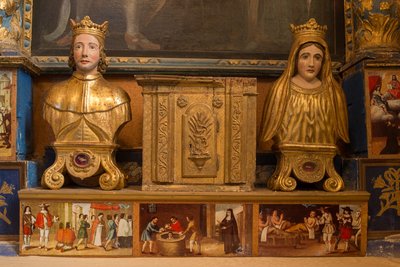
Reliques de Saint-Elzéar - ©Commune d'Ansouis  Patrimony and history
Patrimony and historyPlace Saint-Elzéar
Named Elzéar Sabran who was born in Provence in 1285 and was married to Delphine (Dauphine) sign, which was destined to take orders. They lived their married life in asceticism and virginity. Elzear died September 27, 1325 and was canonized April 15, 1369. Delphine made vows of poverty and ended his life in Apt in the greatest destitution. The Church blessed and proclaimed the popular will, Ste. Ansouis always celebrates in September the Saints.
Description
With your back to the tourist office, pass the Place de la Vieille Fontaine, cross the road and go up the Rue de France. At the first intersection take the Grande Rue to the left and follow it.
1- At the castle square, turn left and reach the church's forecourt. Go back your steps until the castle square (point 1). Turn left onto the Rue du Cartel. Turn once right on Rue des Remparts, then leave the stairs behind and go down to the left to turn right on the Rue du Grand Four. Continue through the arch to reach the castle square. Go down to the left and reach the Rue du Petit Portail.
2- Continue to the left on 30m and rush right into the Rue du Buis. Continue right and then turn left after the Esquicho-couido connecting path to reach the Rue Basse.
3- Turn left. At the fountain, continue left. Pass through the Colombier connecting path, then the Place des Hôtes and reach the Place Saint-Elzéar.
4- Drive down the Boulevard des Platanes. At the roundabout take a left, go under the porch and take a right to reach the Place de la Vieille Fontaine and the Tourist Office.
- Departure : Tourist Office, Place de la Vieille Fontaine, Ansouis
- Arrival : Tourist Office, Ansouis
- Towns crossed : Ansouis
Forecast
Altimetric profile
Recommandations
Be careful crossing the road at the start and along the road to return.
Information desks
House of the Luberon Regional Nature Park
60, place Jean Jaurès, 84400 Apt
In the heart the old town centre of Apt, the House of the Luberon Regional Nature Park welcomes you in a town house of the 18th century. The permanent exhibition of the geology museum has a rich collection of fossils evidencing the geological history of the Luberon.
On sale at the shop: books, maps, guidebooks, games, posters...
Open Monday to Friday from 8:30 am to 12:00 pm and from 1:30 pm to 6 pm (and on Saturday, depending on the program). Free admission.
OTI Luberon Sud Tourisme
Le Château - BP 16, 84240 La Tour d'Aigues
Access and parking
At 8km Northwest of Pertuis, by the D56 and the D37.
Parking :
Access
- Emergency number :
- 114
More information
Source

Report a problem or an error
If you have found an error on this page or if you have noticed any problems during your hike, please report them to us here:


